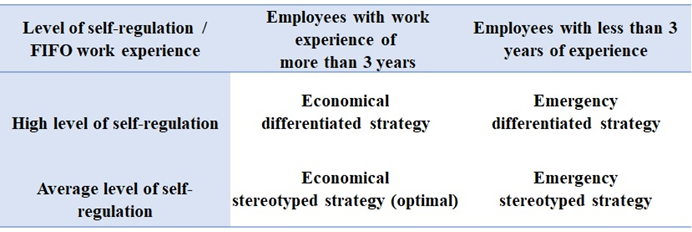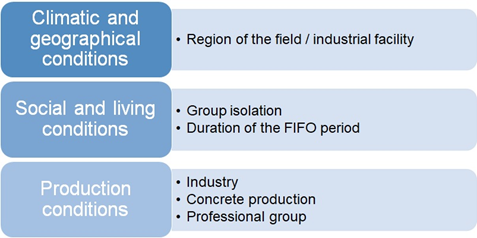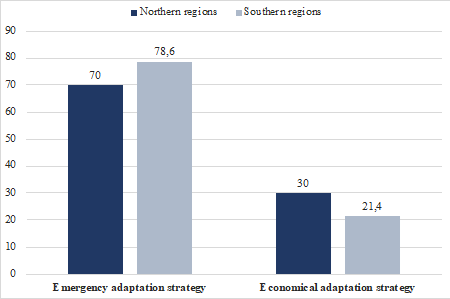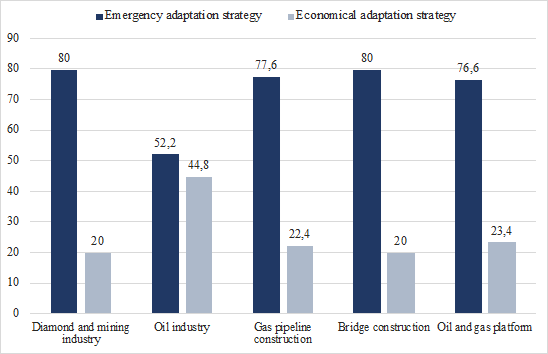Abstract
The article presents a differential analysis of the adaptation strategies of fly-in-fly-out personnel. The study involved 359 fly-in-fly-out workers operating in the south and north of Russia. Empirical material was collected through five scientific expeditions in the fields of diamond, oil and gas production, the construction of gas pipelines, the construction of a bridge and an offshore oil platform. Research methods are questioning, psychophysiological and psychological testing aimed at the diagnosis of functional conditions and personal characteristics of the staff. Statistical processing was carried out using descriptive statistics and Pearson's X 2. In the framework of this work, we proceed from the understanding of adaptation strategies as the holistic management of an employee by his ergatic system, aimed at maintaining the necessary level of working capacity and functional state in the process of fulfilling professional duties in various conditions while preserving the employee’s physical and mental health, and considered for a long completed period of time . The study revealed the prevailing types of adaptation strategies (economical and emergency) among representatives of various industries and depending on the region where the industrial facility is located. The study was carried out in continuation of the empirical studies series on the socio-environmental professional adaptation of fly-in-fly-out personnel.
Keywords: Fly-in-fly-out workextreme conditions of professional activityadaptation strategy
Introduction
As resource demand continues to grow worldwide, an increasing number of mining projects are located in regions remote from human settlements. Due to the remote location of resources, companies seeking to extract these sites have introduced a special method of labor organizing for their employees — the fly-in-fly-out method or FIFO ( Houghton, 1993). The fly-in-fly-out method (FIFO) is defined as “any employment in which work is so isolated from workers' homes that they are provided with food and housing at the workplace, and lists are created according to which workers spend a fixed number of days on the site, followed by a fixed number of days at home” ( Storey & Shrimpton, 1989, p. 2).
The fly-in-fly-out employment continues to expand and is currently being used to service all areas of remote production, including both offshore oil and gas and onshore production projects. It is important to note that the fly-in-fly-out method is the only viable option for the offshore oil and gas industry, since, unlike onshore mine sites, daily trips to work are not possible and permanent premises are not available ( Storey, 2001; Zhao et al., 2017).
Problem Statement
Previous studies have established that the professional activities of fly-in-fly-out workers in the Far North and the Arctic require the creation of conditions for physiological, psychological and socio-psychological adaptation ( Adams et al., 2019; Albrecht & Anglim, 2018; Khasnulin & Khasnulina, 2012; Korneeva et al., 2017; Korneeva & Simonova, 2018; Mette et al., 2019; Miller et al., 2019; Vojnovic & Bahn, 2015). Activities in extreme conditions impose special requirements on the professional adaptation of workers, which is due to a combination of many adverse environmental factors and the unpredictability of stressful or emergency situations ( Velasco Garrido et al., 2018; Mette et al., 2018; Gardner et al., 2018; Rebar et al., 2018; Sibbel et al., 2016). In such conditions, adaptation always has an unfinished look and the result of the adaptation process will be formed adaptation strategies. In our previous studies, a classification of adaptation strategies was developed and the prevailing types of adaptation strategies for fly-in-fly-out workers in the Arctic were identified. In connection with the spread of fly-in-fly-out work organization in the central and southern regions and also with the further development of this scientific direction, it is necessary to identify differences and describe the prevailing types of adaptation strategies for fly-in-fly-out workers depending on the region where the industrial facility is located and the type of production.
Research Questions
The environmental resource at various enterprises in different zones of the Russian Federation is significantly different, it is obvious that makes the various manifestations of a personal resource optimal for effective adaptation. It is important to find strategic lines of analysis for ensuring effective professional activity through multidimensional style components of a personal resource
Purpose of the Study
The purpose is to describe the dominance of an emergency or economical adaptation strategy for fly-in-fly-out personnel while differentiating the environmental resource in the region where the industrial facility is located and the type of production.
Research Methods
In the framework of this work, we proceed from the understanding of adaptation strategies as the holistic management of an employee by his ergatic system, aimed at maintaining the necessary level of working capacity and functional state in the process of fulfilling professional duties in various conditions while maintaining the employee’s physical and mental health, and considered for a long completed period of time ( Korneeva et al., 2013).
In our previous studies, the following classification of adaptation strategies was developed (Figure

An economical adaptation strategy assumes that the employee, without increasing his activation level more than necessary, can rebuild in the middle of the fly-in period, when the psychological load becomes excessive, his body starts the mechanism of bilateral regulation for the correct distribution of forces. An emergency adaptation strategy is characteristic of employees with a fly-in-fly-out method of less than three years and is characterized by the following features: it is physiologically oriented and uneven, while it looks effective because it allows you to maintain a relatively high level of functional state until the end of the fly-in period, but ultimately leads to a general decrease in health , which will affect after a couple of years of fly-in-fly-out work.
The listed strategies are highlighted according to a two-factor plan. The first factor - an emergency - economical strategy, is based on the balance of the autonomic nervous system as dominant in the separation of adaptation of different styles. The second factor - differentiated - stereotyped strategies based on the analysis of the semantic spaces of the respondents and also offers various styles of adaptation.
In this part of the study, we will focus on the first factor dividing strategies into emergency and economical.
The differential nature of the analysis is due to the fact that it is built as a climb from the analysis of the most common factors affecting the entire staff of a group of professions to the study of factors that determine the working conditions of individual specialized groups of professions ( Simonova, 2011).
Figure

The research materials were collected through five scientific expeditions to various industrial facilities using the fly-in-fly-out method:
Construction of gas pipelines, the Republic of Komi (Arctic), where 80 employees (the average age was 34.91 ± 0.926, the average length of fly-in-fly-out work was 4.57 ± 0.343, the fly-in duration is 52 days).
Oil production, Nenets Autonomous Okrug (Arctic), where 70 employees (average age 38.46 ± 1.410, average fly-in-fly-out work experience 9.85 ± 1.072, the fly-in duration is 28 days).
Diamond mining, Arkhangelsk Oblast (Far North), where 70 employees (average age 38.56 ± 1.151, average fly-in-fly-out work experience 8.16 ± 0.701, the fly-in duration is 14 days).
Construction of the facility "Crimean bridge", Krasnodar Territory (south), where 82 employees (average age 41.31 ± 1.242, average fly-in-fly-out work experience 8.02 ± 0.721, the fly-in duration is 28 days).
Offshore ice-resistant platform, the Caspian Sea (south), where 50 employees (average age 36.17 ± 1.064, average fly-in-fly-out work experience 7.97 ± 0.839, the fly-in duration is 14 days).
Research method is psychological testing with Luscher ( 1971) Color Test and Aminev´ Interpretation Coefficients for this test ( Aminev, 1982, p. 18), in particular, the calculation of the vegetative balance. The interval of change of the indicator is from -9.9 to + 9.9. Positive values mean the predominance of the tone of the sympathetic nervous system prevails, i.e. mobilization of all functions, preparation for active defence (emergency adaptation strategy); negative - the predominance of the tone of the parasympathetic nervous system, i.e. the body’s work is aimed at resting, restoring strength, saving resources (economical adaptation strategy).
Statistical processing was carried out using descriptive statistics and Pearson's chi-squared test (
Findings
Research Results
As a result of our study, it was found that 73.3% of all surveyed employees use an emergency adaptation strategy, and 26.7% use an economical one.
In this study, we consider the differences in the adaptation strategies choice of workers at the climatic and geographical conditions - depending on the region where the field is located (northern or southern) - Figure

As can be seen from the data in Figure
At the level of production conditions, depending on the type of production, the following differences were identified in the choice of adaptation strategies for fly-in-fly-out personnel - Figure

As can be seen from the data in Figure
Regarding the construction of the bridge, the choice of an adaptation strategy may be determined by favourable environmental factors ( Korneeva & Simonova, 2019). At the industrial facility under consideration, group isolation is minimal, because the fly-in-fly-out camp and the facility itself are located on the territory of the settlement. Consequently, even with the spontaneous formation of an adaptation strategy, it is possible to compensate for the quick use of internal resources of workers by restoring them using all the opportunities located in the territory of these settlements.
One of the industries where the use of both emergency and economical strategies is equally represented is oil and gas production. It should be noted that due to the length of the fly-in period of 28 days in the organization, employees have the opportunity to manage their time and to purposefully formulate an economical strategy. This is also due to the strengthening of the environmental resource, which includes the optimal organization of the life of workers in the fly-in-fly-out camp, the optimization of production through the use of modern equipment and technologies. Under the extreme impact of climatic and geographical polar conditions, greater attention is required to improve the environmental resource in order to ensure optimal efficiency in the workplace, preserving the health and well-being of workers.
Discussion of the results
Our previous studies also found that diamond workers are more likely to use an emergency adaptation strategy, while oil and gas workers are more economical ( Korneeva et al., 2013). The results obtained allow us to expand our understanding of the effectiveness of adaptation strategies. Earlier, when researching fly-in-fly-out personnel at oil and gas exploration and oil and gas production enterprises in the Arctic zone, we found that the optimal type of adaptation strategy is economical stereotyped. At the moment, we can say that with the improvement of the environmental resource, other types of adaptation strategies may be optimal. In other words, the optimality of the type of adaptation strategies is determined depending on the consideration of factors at each level of differential analysis (from the region where the field / industrial facility is located to a professional group). In our further research, we will continue research in this direction, taking into account data from other levels of differential analysis of the professional activity of fly-in-fly-out personnel.
Conclusion
Differential analysis revealed differences in the prevailing types of adaptation strategies depending on the production and region of the industrial facility. It was revealed that fly-in-fly-out workers in the south of the Russia more often use an emergency adaptation strategy compared to colleagues in the northern regions. It has been established that workers of most industries are characterized by the use of an emergency adaptation strategy. At the same time, and only in oil and gas production, fly-in-fly-out workers more often use economical strategies. We assume that this is due to the duration of the fly-in period and the characteristics of the environmental resource at the enterprise we studied. This study continues a series of works demonstrating that adaptation strategies are formed as the interconnection of elements of a personal resource that changes in response to a change in the goals and objectives of a professional activity, its conditions, motives, and state of a performer.
Acknowledgments
Project FSRU-2020-006 as part of the Russian state task for fundamental research "Assessment of psychological risks in the professional activities of extreme specialists", 2020-2022.
References
- Adams, M. E., Lazarsfeld-Jensen, A., & Francis, K. (2019). The implications of isolation for remote industrial health workers. Rural and remote health. 19(2). 5001. https://doi.org/10.22605/RRH5001
- Albrecht, S. L., & Anglim, J. (2018). Employee engagement and emotional exhaustion of fly-in-fly-out workers: A diary study. Australian Journal of Psychology, 70(1), 66-75. https://doi.org/10.1111/ajpy.12155
- Aminev, G. A. (1982). Matematicheskie metody v inzhenernoj psihologii [Mathematical methods in engineering psychology]. Ufa: BSU.
- Degteva, G. N., Korneeva, Y. A., & Simonova, N. N. (2017). Personal resources of oil and gas workers for the purposes of adaptation to the negative Arctic climate and geographical conditions. Human Ecology (Russian Federation), 9, 5-21. https://doi.org/10.33396/1728-0869-2017-9-15-21
- Gardner, B., Alfrey, K.-L., Vandelanotte, C., & Rebar, A. L. (2018). Mental health and well-being concerns of fly-in fly-out workers and their partners in Australia: a qualitative study. BMJ Open, 8(3), e019516, https://doi.org/10.1136/bmjopen-2017-019516
- Houghton, D. (1993). Long distance commuting: A new approach to mining in Australia. The Geographical Journal, 159(3), 281-290. https://doi.org/10.2307/3451278
- Khasnulin, V. I., & Khasnulina, A. V. (2012). Psikhoėmot͡sionalʹnyĭ stress i meteoreakt͡sii͡a kak sistemnye proi͡avlenii͡a dizadaptat͡sii cheloveka v uslovii͡akh izmenenii͡a klimata na severe Rossii [Psycho-emotional stress and meteoreacton as systemic manifestations of human disadaptation under changing climatic conditions in the North of Russia]. Human Ecology (Russian Federation), 8, 3-7. https://journals.eco-vector.com/1728-0869/article/view/17448
- Korneeva, Y. A., & Simonova, N. N. (2018). Analysis of psychological risks in the professional activities of oil and gas workers in the far north of the Russian Federation. Behavioral Sciences, 8(9), 84. https://doi.org/10.3390/bs8090084
- Korneeva, Y. A., & Simonova, N. N. (2019). Psychological features of adaptation of oil and gas workers in the arctic and in the south of Russia. Society of Petroleum Engineers - Symposium: Asia Pacific Health, Safety, Security, Environment and Social Responsibility 2019. https://doi.org/10.2118/195426-MS
- Korneeva, Y. A., Simonova, N. N., Degteva, G. N., & Dubinina, N. I. (2013). Shift workers adaptation strategies in the far North. Human Ecology (Russian Federation), 9, 9-16. https://doi.org/10.33396/1728-0869-2013-9-9-16
- Luscher, M. (1971). The Luscher color test. Simon and Schuster.
- Mette, J., Robelski, S., Kirchhöfer, M., Harth, V., & Mache, S. (2019). Living the 14/14 schedule: Qualitative analysis of the challenges and coping strategies among families of offshore wind workers. Int J Environ Res Public Health, 16(2), 241. https://doi.org/10.3390/ijerph16020241
- Mette, J., Velasco Garrido, M., Harth, V., Preisser, A. M., & Mache, S. (2018). Healthy offshore workforce? A qualitative study on offshore wind employees’ occupational strain, health, and coping. BMC Public Health, 18, 172. https://doi.org/10.1186/s12889-018-5079-4
- Miller, P., Brook, L., Stomski, N. J., Ditchburn, G., & Morrison, P. (2019). Depression, suicide risk, and workplace bullying: a comparative study of fly-in, fly-out and residential resource workers in Australia. Australian health review: a publication of the Australian Hospital Association, 44(2) 248-253. https://doi.org/10.1071/AH18155
- Rebar, A. L., Alfrey, K. L., Gardner, B., & Vandelanotte, C. (2018). Health behaviours of Australian fly-in, fly-out workers and partners during on-shift and off-shift days: an ecological momentary assessment study. BMJ Open 8(12), e023631. https://doi.org/10.1136/bmjopen-2018-023631
- Sibbel, A. M., Kaczmarek, E., & Drake, D. (2016). Fly-In/Fly-Out Accommodation: Workers’ Perspectives. In Haslam McKenzie F. (Eds.) Labour Force Mobility in the Australian Resources Industry. Springer, Singapore. https://doi.org/10.1007/978-981-10-2018-6_8
- Simonova, N. N. (2011). Adaptacionnye processy professional'noj deyatel'nosti rabotayushchih vahtovym metodom [Adaptation processes of professional activity working on a shift basis]. Problemy zdravoohraneniya i social'nogo razvitiya Arkticheskoj zony Rossii [Problems of health and social development of the Arctic zone of Russia.]. Ed. G.N.Degteva. Moscow: Paulsen. 204-225.
- Storey, K. (2001). Fly-in/fly-out and fly-over: mining and regional development in Western Australia. Australian Geographer, 32(2), 133–148. https://doi.org/10.1080/00049180120066616
- Storey, K., & Shrimpton, M. (1989). Long distance labour commuting in the Canadian mining industry. (Working Paper No. 43) Kingston, Ontario: Queen's University, Centre for Resource Studies. https://archive.org/details/longdistancelabo0000stor
- Velasco Garrido, M., Mette, J., Mache, S., Harth, V., & Preisser, A. M. (2018). A cross-sectional survey of physical strains among offshore wind farm workers in the German exclusive economic zone. BMJ Open, 8 e020157. https://doi.org/10.1136/bmjopen-2017-020157
- Vojnovic, P., & Bahn, S. (2015). Depression, anxiety and stress symptoms among fly-in fly-out Australian industry workers. Journal of Health, Safety and Environment, 31(3), 207-223.
- Zhao, Y., Russell, D. J., Guthridge, S., Ramjan, M., Jones, M. P., Humphreys, J. S., Carey, T. A., & Wakerman, J. (2017). Long-term trends in supply and sustainability of the health workforce in remote Aboriginal communities in the Northern Territory of Australia. BMC Health Services Research, 17. https://doi.org/10.1186/s12913-017-2803-1
Copyright information

This work is licensed under a Creative Commons Attribution-NonCommercial-NoDerivatives 4.0 International License.
About this article
Publication Date
26 October 2020
Article Doi
eBook ISBN
978-1-80296-090-7
Publisher
European Publisher
Volume
91
Print ISBN (optional)
-
Edition Number
1st Edition
Pages
1-340
Subjects
Self-regulation, personal resources, educational goals, professional goals, mental health, digitalization
Cite this article as:
Korneeva, Y. A., & Simonova, N. N. (2020). Differential Analysis of Adaptation Strategies of Fly-In-Fly-Out Personnel. In V. I. Morosanova, T. N. Banshchikova, & M. L. Sokolovskii (Eds.), Personal and Regulatory Resources in Achieving Educational and Professional Goals in the Digital Age, vol 91. European Proceedings of Social and Behavioural Sciences (pp. 288-296). European Publisher. https://doi.org/10.15405/epsbs.2020.10.04.36

